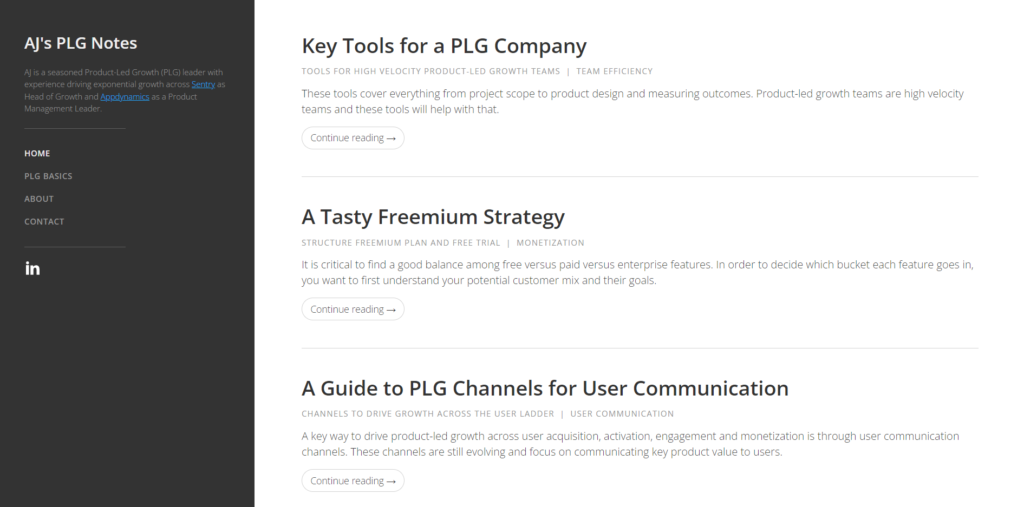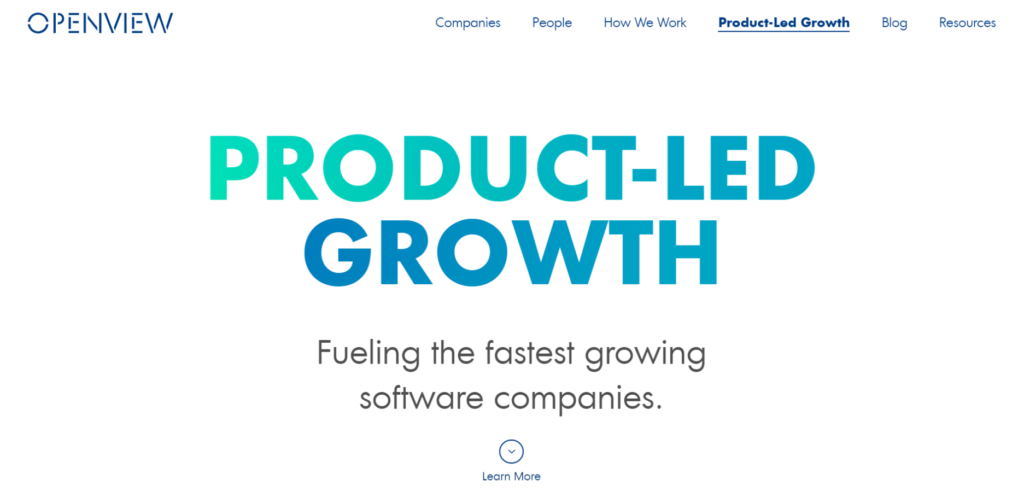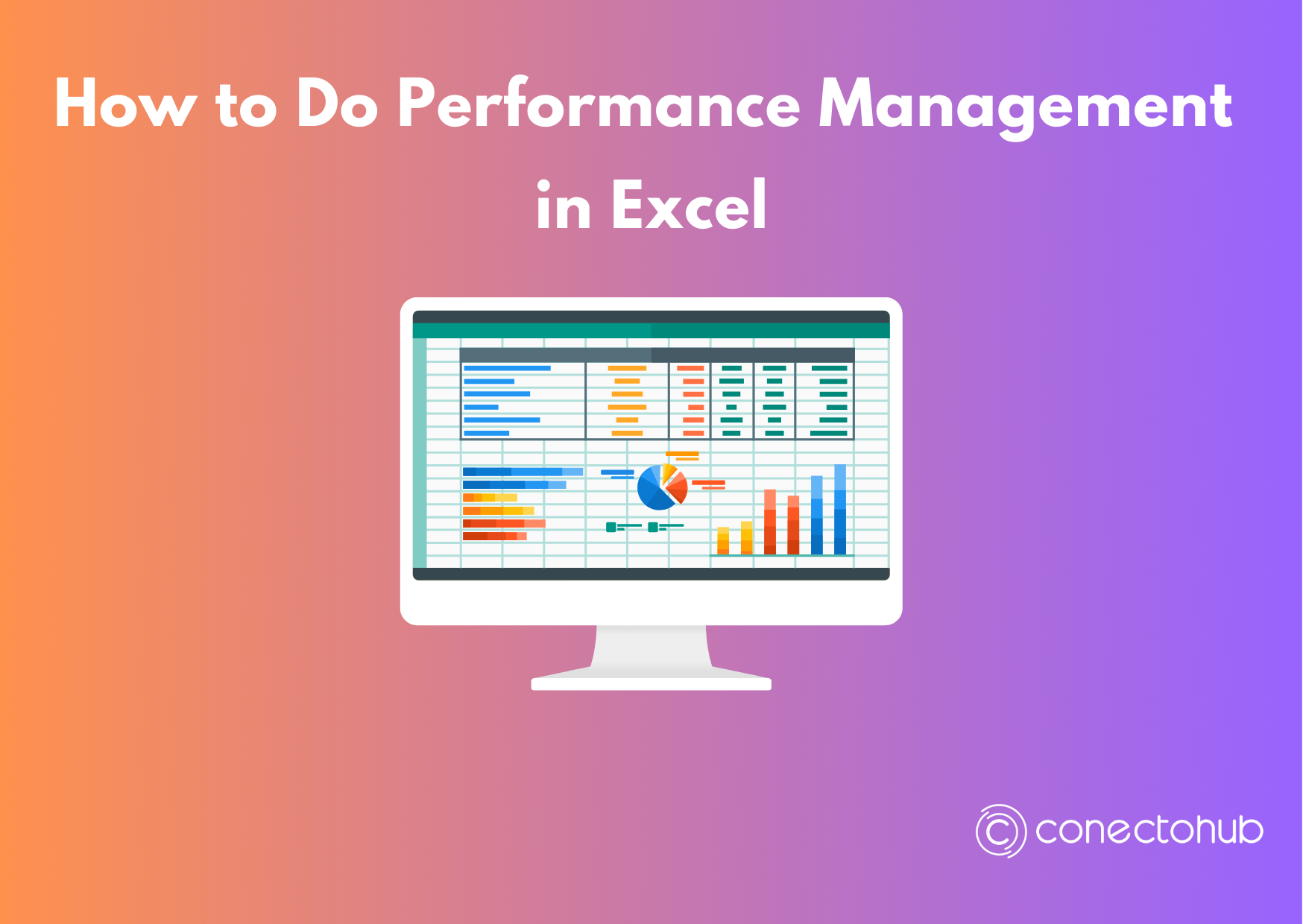Performance management is a crucial aspect of any successful business, involving the regular assessment and tracking of employee performance to ensure alignment with organizational goals. While many sophisticated tools and platforms exist, Excel remains a choice for performance management due … Read More

In a Product-Led Growth strategy, the product is the primary vehicle behind the customer journey. This means that the product is involved in every stage of the customer journey, from acquisition to expansion, and this journey starts as soon as a customer engages with the product.
This journey map, shown above, is then the driver for each stage of the customer journey and your company:
AWARENESS -> ACQUISITION -> ACTIVATION -> ENGAGEMENT and, finally -> MONETIZATION
You should define key PLG Goals and Metrics for each stage
AWARENESS
Goal: Increase sales-ready users
KR 1: Convert %20 MQL to SQL
KR 2: Book 100 product demo
Goal: Drive traffic to landing page
KR 1: Increase ad efficiency from %5 to %15
KR 2: Increase SEO ranking by %15
KR 3: Increase the number of pages viewed from 3.5 to 5.0 per session
Goal: Build a killer lead generation funnel
KR 1: Increase Website-to-Trial conversion by %24
KR 2: Increase MQL(Marketing Qualified Lead) by %25
ACQUISITON ($0-$1k MRR)
Goal: Drive user acquisition engine
KR 1: Decrease CAC(Customer Acquisition Cost) from $100 to $80
KR 2: Improve signup page conversion to %80
KR 3: Increase PQL(Product Qualified Lead) to %25
Goal: Generate new sales pipelines
KR 1: Generate 5 pipelines by industry
KR 2: Generate 10 pipelines by country
Goal: Increase sales-ready users
KR 1: Convert %20 PQL to SQL
KR 2: Book 100 product demo
Goal: Develop a great first-experience for user
KR 1: Improve NPS from 8 to 9.2
KR 2: Collect 40 Capterra and G2 reviews
KR 3: Increase refer a friend clicks from %15 to %25
Goal: Deliver security, quality and performance
KR 1: Reduce Avg. API Response Time to 2 ms
KR 2: Get %100 success from PENTEST
KR 3: Increase page open speed by %20
Goal: Generate high quality TOFU traffic
KR 1: Increase MQL(Marketing Qualified Lead) by %25
KR 2: Drive Trial Conversion Rate to %20
Goal: Increase overall trial start velocity
KR 1: Decrease website Bounce Rate by %40
KR 2: Increase weekly new users by %35
ACTIVATION ($1k-$10k MRR)
Goal: Generate new sales pipelines
KR 1: Generate 5 pipelines by industry
KR 2: Generate 10 pipelines by country
Goal: Increase sales-ready users
KR 1: Convert %20 MQL to SQL
KR 2: Book 100 product demo
Goal: Get closer to new users for training and feedback
KR 1: Decrease avg ticket reply duration to 1 hour
KR 2: Decrease avg ticket solution duration to 2 days
Goal: Highligt USP of the product
KR 1: Increase visit rate by %30 on the trial
KR 2: Reach min. 5 minutes session time %90 of first logins
KR 3: Trial-to-Paid conversion to %40
KR 4: Decrease TTV(Time to Value) to 2 days
Goal: Deliver security, quality and performance
KR 1: Reduce Avg. API Response Time to 2 ms
KR 2: Get %100 success from PENTEST
KR 3: Increase page open speed by %20
Goal: Increase new user engagement
KR 1: Increase GRR(Growth Revenue Retention) to %90
KR 2: Increase refer a friend clicks from %15 to %25
Goal: Convert MQL users to SQL
KR 1: Increase MQL to SQL ratio to %30
KR 2: Drive Trial Conversion Rate to %20
Goal: Increase overall trial start velocity
KR 1: Decrease website Bounce Rate by %40
KR 2: Increase weekly new users by %35
ENGAGEMENT (10k-100k MRR)
Goal: Drive new feature adoption
KR 1: Reach 10.000 CTA click rate about new feature
KR 2: Get %70 usage rate from CTA
KR 3: Reach %35 feature adoption rate
Goal: Convert users to loyal customers
KR 1: Increase number of repeat logins by %30
KR 2: Increase number of invitation by user by %30
KR 3: Reach %80 90-Day retention rate
Goal: Grow deal size
KR 1: Increase self-serve to customer ratio from %8 to %15
KR 2: Increase close rate from %22 to %27
KR 3: Increase MRR $0.3 per customer by upselling new features
Goal: Improve ACV( Annual Contract Value)
KR 1: Convert 50 business plan customers to enterprise plan
KR 2: Increase ASP(Average Selling Price) by %15
Goal: Set HELPING mindset instead of selling
KR 1: Decrease CIR(Call in Rate) to 4
KR 2: Increase number of SMB demos by %40
Goal: Refine business model and understanding of levers
KR 1: Increase partner revenue by %40
KR 2: Reach 25 months Burn Rate
Goal: Create company culture and boost engagement
KR 1: Decrease Employee Turnover Rate to %10
KR 2: 100% of team members include 360-feedback process this quarter
Goal: Apply Diversity and inclusion work culture
KR 1: Improve number of diverse candidates in the pipeline by 20%
KR 2: Revise 100% of our job descriptions with inclusive language
Goal: Employee retention
KR 1: Turnover Rate to %10
KR 2: eNPS to 9.5
Goal: Find the best talents for company
KR 1: Decrease Time to fill open positions to 25 days
KR 2: Decrease time to hire to 10 days
Goal: Engage with high quality accounts and drive usage and engagement
KR 1: Improve LTV(Lifetime Value) by %45
KR 2: MRR Renewal rate to %90
Goal: Improve partner relationship to drive product usage
KR 1: Increase partner MRR by %20
KR 2: Improve marketplace active users by %10
Goal: Get closer to customer for feedback and training
KR 1: Improve Release Notes mail campaign click rate to %15
KR 2: Provide 2.500 attendees usage and tricks webinars for this quarter
KR 3: Get 10.000 views from new feature videos on Youtube
Goal: Drive engagement and expansion revenue
KR 1: Increase DAU(Daily Active Users) by %25
KR 2: Reach $40k MRR
KR 3: Increase retention rate from %70 to %85
Goal: Develop partnership ecosystem
KR 1: Increase partner MRR by %20
KR 2: Improve marketplace active users by %15
Goal: Deliver security, quality and performance
KR 1: Reduce Avg. API Response Time to 2 ms
KR 2: Get %100 success from PENTEST
KR 3: Increase page open speed by %20
Goal: Convert MQL users to SQL
KR 1: Increase MQL to SQL ratio to %30
KR 2: Drive Trial Conversion Rate to %20
Goal: Create educational and engagement contents
KR 1: Get 10.000 views from new feature videos on Youtube
KR 2: Reach 5.000 email newsletter subscriber
Goal: Push funnel efficiency to the limits
KR 1: Increase Website-to-Trial conversion by %24
KR 2: Increase MQL(Marketing Qualified Lead) by %25
KR 3: Increase SQL(Sales Qualified Lead) by %30
MONETIZATION (100k+ MRR)
Goal: Convert self-serve users into high lifetime value customers
KR 1: Improve Trial to Paid conversion from %20 to %35
KR 2: Decrease sales cycle to 70 days
KR 3: Increase New ACV Bookings by %30
Goal: Improve ACV( Annual Contract Value)
KR 1: Convert 150 mid-sized customers to the enterprise level
KR 2: Increase ASP(Average Selling Price) by %15
Goal: Create company culture and boost engagement
KR 1: Decrease Employee Turnover Rate to %10
KR 2: 100% of team members include 360-feedback process this quarter
Goal: Apply Diversity and inclusion work culture
KR 1: Improve number of diverse candidates in the pipeline by 20%
KR 2: Revise 100% of our job descriptions with inclusive language
Goal: Employee retention
KR 1: Turnover Rate to %10
KR 2: eNPS to 9.5
Goal: Find the best talents for company
KR 1: Decrease Time to fill open positions to 25 days
KR 2: Decrease time to hire to 10 days
Goal: Engage with high quality accounts and drive usage and engagement
KR 1: Improve LTV(Lifetime Value) by %45
KR 2: MRR Renewal rate to %90
Goal: Improve partner relationship to drive product usage
KR 1: Increase partner MRR by %20
KR 2: Improve marketplace active users by %10
Goal: Get closer to customer for feedback and training
KR 1: Improve Release Notes mail campaign click rate to %15
KR 2: Provide 2.500 attendees usage and tricks webinars for this quarter
KR 3: Get 10.000 views from new feature videos on Youtube
Goal: Expansion revenue
KR 1: Grow ARR by %45
KR 2: Reach $100k MRR
KR 3: Increase DAU(Daily Active Users) by %25
Goal: Expand partnership revenue
KR 1: Increase partner MRR by %20
KR 2: Improve marketplace cross-sell by %25
Goal: Deliver security, quality and performance
KR 1: Reduce Avg. API Response Time to 2 ms
KR 2: Get %100 success from PENTEST
KR 3: Increase page open speed by %20
Goal: Convert MQL users to SQL
KR 1: Increase MQL to SQL ratio to %50
KR 2: Drive Trial Conversion Rate to %40
Goal: Create educational and engagement contents
KR 1: Get 50.000 views from new feature videos on Youtube
KR 2: Reach 10.000 email newsletter subscriber
Goal: Push funnel efficiency to the limits
KR 1: Increase Website-to-Trial conversion by %24
KR 2: Increase MQL(Marketing Qualified Lead) by %25
KR 3: Increase SQL(Sales Qualified Lead) by %30
PLG Metric Glossary
Activation Rate helps companies determine how quickly and effectively their new users are achieving perceived value. It measures the number of new users that have performed a predetermined “key action” within a set period of time, where the key action is assumed or known to deliver initial customer value.
#ACTIVATED USERS / #TOTAL USERS IN PERIOD
The ARR metric is a way to measure the recurring revenue that a customer has with a company over the course of a 12-month period. This metric is most commonly used by software as a service (SaaS) businesses and other subscription-based businesses that have a minimum contract duration of 12 months. The ARR metric is calculated in different ways depending on the type of contract, but the basic math is relatively simple.
Average Selling Price (ASP) is the average price a given product is sold for. This metric can be applied narrowly to a product or service or, more broadly, to an entire market. It’s a common metric, often used to compare businesses or channels and is particularly interesting as a reflection of what consumers will pay for similar products or services.
#REVENUE / #SALES COUNT
Customer Acquisition Cost
Especially for SaaS companies, it is a metric that identifies new customers and calculates how much these customers will cost. Thanks to this metric, SaaS companies can calculate how their customers will affect their company budget. CAC is usually figured for a specific time range, such as a year , a month (it changes according to companies).
CAC needs to be more explained. To give an example, let’s say you own a company. Your company needs new customers. So, how can you use the CAC metric?

#NEW CUSTOMERS (Number Of People) 
Close Rate is the percentage of Leads who entered the sales funnel and are now “Closed Won” Customers. This is one of the most ubiquitous sales conversion metrics and is a strong indication of product market fit, pricing, and sales execution. It’s also a key metric in aligning your marketing, sales, and product teams.
#WON CUSTOMERS / #TOTAL LEADS
Trial Conversion Rate measures the percentage of users that have converted to a paid account from a trial period. Commonly referred to as Free Trial to Paid Conversion Rate, this metric indicates product value by measuring the number of users that find enough value in the product to pay for it. Trial Conversion Rates vary based on the type of trial you use. In SaaS, the standard practice is to either have a freemium product or a free trial period that usually spans a couple weeks.
#CONVERTED USERS / #TOTAL USERS IN PERIOD
You have customers using an application that you use or make for your company. But, are all these customers unique users who are really active in your product?
You can use DAU (Daily Active Users) and MAU (Monthly Active Users) metrics to answer this question.
The DAU metric is a key performance indicator for many online businesses and SaaS companies. This metric stands for Daily Active Users (DAU) and represents the number of unique users who visit your site or use your app each day.
Similarly, the MAU metric stands for Monthly Active Users (MAU) and represents the number of unique users who visit your site or use your app monthly. The MAU metric is calculated on a monthly basis and to find the MAU metric, you must divide the total DAU by the number of days in the month.
 Product stickiness is called the DAU to MAU ratio, a measure of how often customers return to your app!
Product stickiness is called the DAU to MAU ratio, a measure of how often customers return to your app!
#TOTAL DAU 
Employee Net Promoter Score (eNPS) is a method built around the Net Promoter Score (NPS) to measure employee loyalty. It measures how willing your employees are to recommend their workplace to their family or friends.
eNPS is calculated using the following formula: eNPS = percentage of Promoters minus percentage of Detractors. The result can range from -100 to +100.
%PROMOTERS – % DETRACTORS
Lifetime Value (LTV) metric indicates the total revenue a business can reasonably expect from a single customer account. It considers a customer’s revenue value and compares that number to the company’s predicted customer lifespan. Businesses use this metric to identify their most valuable customer segments.
AVG MRR PER USER x CUSTOMER LIFETIME
A Marketing Qualified Lead (MQL) is a universal metric used by marketing teams to measure the quality of leads they generate and pass to sales. Most marketing teams have targets associated with MQLs that include number of MQLs and acceptance rate, for example, leads that go on to become Sales Accepted Leads.
#MQL
Sales Cycle is the count of the number of days or months it takes on average to close a deal. This metric can be helpful when creating sales forecasts, measuring sales efficiency, and speaking with investors. It is often referred to as the Average Deal Cycle and is usually expressed in months.
#TOTAL SALES DAYS / #TOTAL SALES COUNT
Time to Value (TTV) measures the duration between when a user selects your product and the moment they initially realize the value of your product. Value usually means that the setup process is completed and the first usage of the product is successful.
#CONVERTED USERS / #TOTAL USERS IN PERIOD
Useful PLG Resources

AJ's PLG Notes
AJ is a seasoned Product-Led Growth (PLG) leader with experience driving exponential growth across Sentry as Head of Growth and Appdynamics as a Product Management Leader.

Product-Led Growth
Product-led growth (PLG) is an end user-focused growth model that relies on the product itself as the primary driver of cust..
Stratejik İnsan Kaynakları Yönetimi
Stratejik İnsan Kaynakları Yönetimi organizasyonların çalışanlarını yönetmek için kullandıkları bir süreçtir. Organizasyonun insan kaynaklarının, organizasyonun hedeflerini destekleyecek şekilde kullanılmasını sağlama yoludur. Bunu, insan kaynakları ile şirketin hedefleri arasında bir köprü olarak düşünebilirsiniz. Stratejik İnsan Kaynakları Yönetimi ile işletmeler, çalışan performansı … Read More
Supercharge Your Team: Best OKR Examples
In today’s fast-paced business world, setting clear and achievable goals is more important than ever. Objectives and Key Results (OKRs) offer a dynamic framework for setting these goals, enabling organizations of all sizes to achieve remarkable success. Whether you’re a … Read More

 TOTAL YEARS IN CONTRACT
TOTAL YEARS IN CONTRACT


